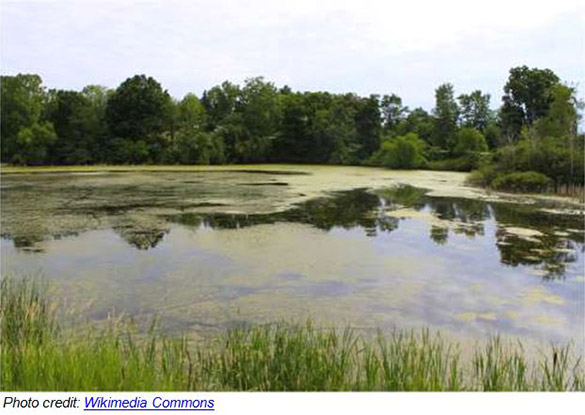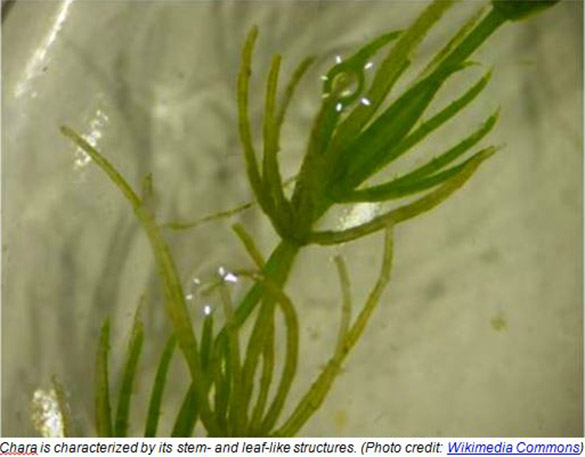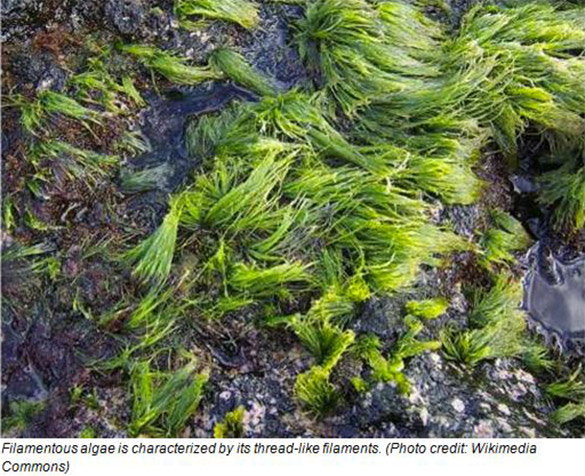
What Does Algae Growth Look Like?
Algae growth is extremely common in any water exposed to sunlight. But in fresh water farm ponds, there is increased risk for three particular types of algae:
Chara (pictured below)is a flower-like algae known for its “branches” that typically remains below the water’s surface. It also has a strong, musky odor and a crunchy feel.

Filamentous algae (pictured below), most common in north Texas ponds, look like thread-like structures completely lacking in leaves. Farmers will often notice these “mats” floating at the pond’s surface and often describe them as “a mass of wet wool” or “bright green hay.”

Single-celled and colonial algae (along with filamentous algae) are microscopic species of algae that can give rise to harmful algal blooms. While other forms of algae may be visible immediately when you look at your pond, these typically can’t be seen with the naked eye. However, that doesn’t mean they can’t cause some problems in the irrigation process or release toxins into agricultural water. The National Marine Sanctuaries suggests looking for a blue-green tint in your water as one way to identify these potentially harmful blooms.
What are the Risk Factors?
According to Purdue University’s Department of Horticulture and Landscape Architecture, there are some other factors besides the weather than can lead to potentially inconvenient algae growth. (Although all farmers should note that even under ideal conditions, surface water almost always contains algae and requires treatment if being used for irrigation.)
- Pond size: Smaller, shallower ponds allow more light and heat to infiltrate the water, facilitating algae growth.
- Water movement: Stagnant water, especially at shallow depth, can allow algae growth to accelerate. Ponds with more aggressive wave action and movement are less favorable to algae growth.
- Nutrients: High levels of nutrients, such as phosphorus and nitrogen, essentially serve as fertilizer for algae.
How Can I Stop Algae Growth?
When algae-contaminated water is pumped into irrigation lines, big problems can occur, including drip-line clogs that can easily derail an entire day’s work by putting vital equipment out of commission. This hazard to both health and productivity is sometimes known as “biological clogging”—but through effective chlorination and disinfecting of irrigation water, algae growth can be minimized, along costly equipment downtown.
The Accu-Tab® chlorination system is one low-maintenance, cost-effective way to disinfect and prevent algae growth in farm ponds. With no moving parts, no metering pumps, and a process that can be completed easily by just one person, preventing algae growth—as well as water molds and harmful bacteria—has never been more convenient. (Be sure to follow our EPA-approved label directions [PDF].)
Additional precautions that farmers can take include:
- Dredging and deepening ponds. Shallow areas promote more algae growth.
- Protecting irrigation ponds from the influx of fertilizer and runoff from animal grazing areas. Water drainage from fertilized fields and grazing areas can carry fertilizer and nutrients (as well as pathogens) from manure to the pond.
- Nutrient control is important for limiting algal growth. Terrace the adjacent land to avoid runoff into the pond. Using a vegetative filter strip between the pond and adjacent fields may be beneficial where terracing is impractical or inadequate.
- Avoid continuous or extended application of fertilizer through irrigation lines. The constant supply of nutrients would promote ongoing growth of algae and slime layers in these lines.
- Chemically treat fouled irrigation lines with Accu-Tab calcium hypochlorite, following label directions.
To learn more about how Accu-Tab calcium hypochlorite tablets can help streamline your farm’s irrigation process, click here. Interested in Accu-Tab? Request more information online or call us today at 800-245-2974.
